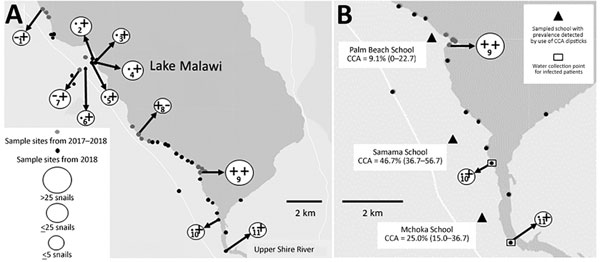Volume 25, Number 3—March 2019
Research Letter
Biomphalaria pfeifferi Snails and Intestinal Schistosomiasis, Lake Malawi, Africa, 2017–2018
Figure

Figure. Locations sampled for Biomphalaria pfeifferi snails and of 3 primary schools where children were tested for intestinal schistosomiasis in the region of Lake Malawi, Africa. A) Locations sampled for B. pfeifferi snails in November 2017 (gray dots) and May 2018 (black dots), Lake Malawi, Africa. + indicates snails present, – indicates snails absent, and ● indicates site not sampled; symbol position indicates year of sampling (left, 2017; right, 2018). Numbers within circles indicate site numbers. Collected snail numbers are indicated by circle size. In 2017, snails were collected at 2 sites and not collected at 12 sites; in 2018, snails were collected at 10 sites and not collected at 47 sites. On each sampling occasion, >50 B. pfeifferi snails were collected at site 9. Coordinates of B. pfeifferi–positive sites: site 1, 14.27752°S, 35.10419°E; site 2, 14.31371°S, 35.14174°E; site 3, 14.31424°S, 35.14383°E; site 4, 14.31354°S, 35.14424°E; site 5, 14.31568°S, 35.14030°E; site 6, 14.32033°S, 35.13613°E; site 7, 14.32100°S, 35.13072°E; site 8, 14.36919°S, 35.17629°E; site 9, 14.39363°S, 35.22104°E; site 10, 14.42708°S, 35.23349°E; and site 11, 14.44928°S, 35.23890°E. B) Location of the 3 sampled primary schools (Palm Beach, 14.391346°S, 35.215137°E; Samama 14.417465°S, 35.217580°E; Mchoka 14.439481°S, 35.220644°E) showing local prevalence (% [95% CI]) of intestinal schistosomiasis indicated by Schistosoma mansoni circulating cathodic antigen (CCA) detected by urine dipstick. Water collection sites pinpointed by 2 Schistosoma egg–positive children from Samama and Mchoka Schools are indicated.